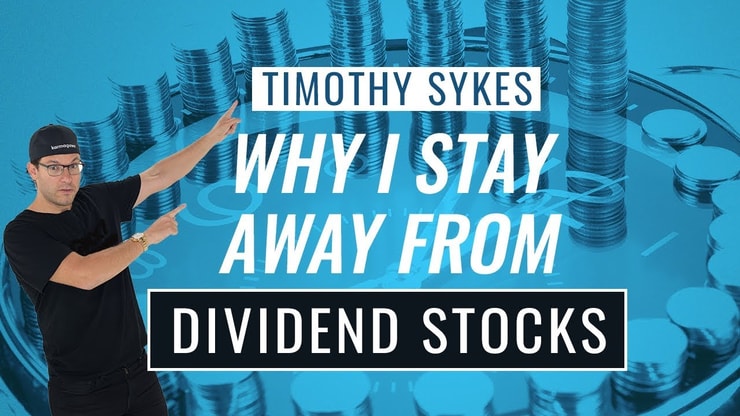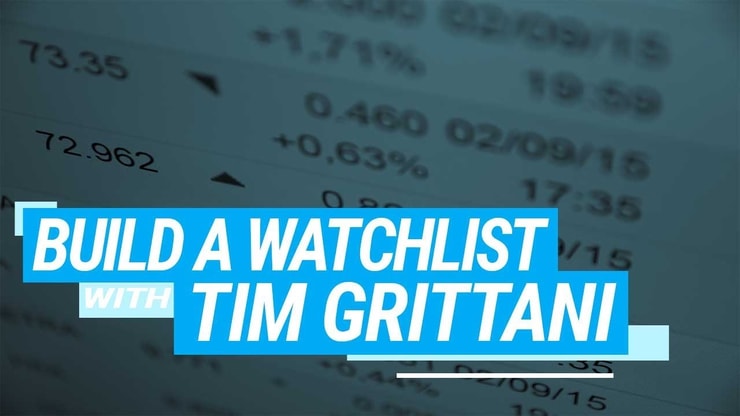High dividend stocks are supposed to be a safe stock option.
If you’ve read my free penny stock guide or subscribe to my YouTube channel, you know I’m all about safety…
I aim for small gains, and I cut losses quickly.
So why don’t I like these high-yield dividend stocks?
I’ll get into that later. First, I want to give you a quick overview of what these stocks actually are.
Table of Contents
- 1 What Are High Dividend Stocks?
- 2 What Is a Dividend?
- 3 Defining High Dividend Stocks
- 4 Why I Don’t Invest in High Dividend Stocks
- 5 18 High-Dividend Stocks
- 5.1 High Dividend Stock #1. Ares Capital Corp. (NASDAQ: ARCC)
- 5.2 High-Dividend Stock #2. Chevron Corp. (NYSE: CVX)
- 5.3 High Dividend Stock #3. GlaxoSmithKline plc (NYSE: GSK)
- 5.4 High Dividend Stock #4. Hess Midstream LP (NYSE: HESM)
- 5.5 High Dividend Stock #5. IBM Common Stock (NYSE: IBM)
- 5.6 High Dividend Stock #6. Kinder Morgan Inc. (NYSE: KMI)
- 5.7 High Dividend Stock #7. Enterprise Products Partners L.P. (NYSE: EPD)
- 5.8 High Dividend Stock #8. Altria Group (NYSE: MO)
- 5.9 High Dividend Stock #9. Annaly Capital Management (NYSE: NLY)
- 5.10 High Dividend Stock #10. New York Community Bancorp (NYSE: NYCB)
- 5.11 High Dividend Stock #11. ONEOK (NYSE: OKE)
- 5.12 High Dividend Stock #12. Owl Rock Capital Corp. (NYSE: ORCC)
- 5.13 High Dividend Stock #13. PPL Corp. (NYSE: PPL)
- 5.14 High Dividend Stock #14. SL Green Realty Corp. (NYSE: SLG)
- 5.15 High Dividend Stock #15. AT&T Inc. (NYSE: T)
- 5.16 High Dividend Stock #16. Valero Energy Corp. (NYSE: VLO)
- 5.17 High Dividend Stock #17. Williams Cos. Inc (NYSE: WMB)
- 5.18 High Dividend Stock #18. Exxon Mobil Corp. (NYSE: XOM)
- 5.19 See the Stocks on My Radar
- 6 Conclusion
What Are High Dividend Stocks?

2025 Millionaire Media, LLCThis one’s pretty easy. A high dividend-yielding stock is a stock that produces high dividends.
As for the harder question…
What Is a Dividend?
A dividend is a payment issued by a company or corporation to shareholders. It might be in the form of cash (cash dividend) or stock (stock dividend).
Dividends are typically paid quarterly. They may also be issued in conjunction with one-time events, such as a big merger.
A dividend’s value is figured by something called a yield. In the context of the stock market, yield is a way of measuring the dividend relative to the share price.
There are quite a few high dividend blue-chip stocks. Why? Since large-cap companies tend to be stable, their stock prices don’t move a ton. Dividends are a nice perk to entice and retain shareholders. It’s the company’s way of showing they notice and appreciate you.
As the shareholder, it’s like you’re receiving a little bonus based on the company’s profits. Dividends are more geared to long-term investors than to traders.
Defining High Dividend Stocks
High-dividend stocks are just that: stocks that pay high dividends.
There isn’t one rate that’s a cutoff for high versus low dividend stocks. It’s because they’re relative to the market. A yield that might be considered high today might have seemed low a decade or two ago.
Most say that 4% or greater is a high-yielding dividend stock. Some might count it from 3%, and some might say 5% or higher.
To get a better idea, you can view a list of the highest dividend stocks on the Nasdaq.
But I don’t think you waste time on stocks with the highest dividends! If a stock is paying a super-high dividend, it’s typically not the safest high-dividend stock. Yes, the yield is higher, but so is the risk level.
Stocks aren’t the only option for high dividends. You can also explore high-dividend stock ETFs. These offer a different way into the dividend-giving world.
Why I Don’t Invest in High Dividend Stocks
First of all — I don’t invest in any stocks. I trade stocks.
Investing in stocks is fine for some people. Maybe they want to profit from market growth without putting in much effort. There are some perfectly nice and relatively safe stocks that would serve that purpose.
Investing in high dividend-paying stocks can be part of this strategy.
The thought is that the best stocks have the best profits. And stocks with the highest dividend yields are the best at sharing these profits.
You get to take profits, and you don’t have to keep tabs on the market — what’s the problem?
Well, there are a few.
First, this ‘set it and forget it’ mindset doesn’t always work.
Take a company like General Electric (NYSE: GE). For years, GE was one of the safest high-yield dividend stocks. It paid a high dividend and was also a growth stock, outside of a few market disruptions.
That all changed a few years ago. As GE’s stock started to dive in 2017, its near-4% dividend held up … for a while. But eventually, it crashed too. And investors were left with a devalued stock with a 0.3% dividend.
Even if there were such a thing as a safe high-dividend stock, I probably still wouldn’t trade it. That’s because stock value is no longer exclusively tied to profits. It’s tied to a company’s future value.
I want the stocks I trade to have a lot of volatility. I want to see their prices go up and down more frequently than their profits do…
If this doesn’t make sense to you, check out my no-cost “Volatility Survival Guide.” It will show you why I stay away from ‘safe’ stocks.
18 High-Dividend Stocks
| Ticker | Company Name | Performance YTD |
|---|---|---|
| ARCC | Ares Capital Corp. | |
| CVX | Chevron Corp. | |
| GSK | GlaxoSmithKline plc | |
| HESM | Hess Midstream LP | |
| IBM | IBM Common Stock | |
| KMI | Kinder Morgan Inc. | |
| EPD | Enterprise Products Partners L.P. | |
| MO | Altria Group | |
| NLY | Annaly Capital Management | |
| NYCB | New York Community Bancorp | |
| OKE | ONEOK | |
| ORCC | Owl Rock Capital Corp. | |
| PPL | PPL Corp. | |
| SLG | SL Green Realty Corp. | |
| T | AT&T Inc. | |
| VLO | Valero Energy Corp. | |
| WMB | Williams Cos. Inc | |
| XOM | Exxon Mobil Corp. |
This high dividend stocks list features some of the highest dividend stocks RIGHT NOW.
That won’t matter much for most short-term traders. Most of these high-yield shares are quarterly, not monthly, dividend stocks. And even if you stick around for the dividend’s pay date, chances are the stock’s value will decline after.
I think these are some of the best high dividend stocks, but it’s not because of their dividends. Check the price action on these stocks. Most are movers, regardless of the amount they pay out.
That makes them the kind of stocks we look for in my Trading Challenge. We’re not interested in steady and predictable stocks. We want stocks that move on news catalysts. And dividend payments can be good catalysts.
Read on for a trader’s view on stocks with high dividend yields. And remember: this is only a list of stocks to watch. This list is in no way a recommendation to trade. Always do your own research and due diligence.
(The definition of ‘best high dividend stock’ is subjective and may differ depending on your trading strategy, knowledge, goals, and circumstances.)
High Dividend Stock #1. Ares Capital Corp. (NASDAQ: ARCC)
-
Latest quarterly dividend: 48 cents/share
-
Dividend yield: 8.65%
Ares Capital Corp. (ARCC) continues to be a cornerstone in the business development company (BDC) sector, offering a robust dividend yield supported by a diversified portfolio of middle-market investments. The company’s consistent performance reflects its prudent underwriting and effective risk management strategies.
In 2025, ARCC’s dividend remains steady at $0.48 per share, with a yield of 8.65%. The company’s payout ratio stands near 96%, indicating a strong capacity to sustain its dividend payments.
For income-focused investors, ARCC offers a compelling combination of high yield and financial stability. Its disciplined investment approach and consistent dividend payments make it a reliable choice in the high-dividend landscape.
High-Dividend Stock #2. Chevron Corp. (NYSE: CVX)
-
Latest quarterly dividend: $1.71
-
Dividend yield: 4.69%
Chevron Corp. (CVX) remains a stalwart in the energy sector, delivering consistent dividends backed by its diversified operations in upstream, midstream, and downstream segments. The company’s strategic asset management and focus on operational efficiency continue to support its financial performance.
As of 2025, Chevron pays a quarterly dividend of $1.71 per share, resulting in an annual dividend of $6.84 and a yield just under 5%. The company has a decades-long track record of dividend increases and a solid balance sheet to support future growth.
For investors seeking stable income from the energy sector, Chevron offers a reliable dividend, underpinned by strong free cash flow and long-term investment in both traditional and renewable energy initiatives.
More Breaking News
- Why Did AeroVironment Stock Surge?
- ITUB’s Unexpected Surge: Analyzing the Latest Performance
- Futu Holdings’ Surprising Stock Surge
High Dividend Stock #3. GlaxoSmithKline plc (NYSE: GSK)
-
Latest quarterly dividend: 42.9 cents
-
Dividend yield: 3.93%
GlaxoSmithKline plc (GSK) continues to deliver steady dividends, supported by its diversified pharmaceutical portfolio and strategic focus on high-growth areas such as oncology and vaccines. The company’s disciplined approach to capital allocation reflects its long-term strategy.
In 2025, GSK’s dividend stands at just under 43 cents per share per quarter, translating to an annual yield of about 3.9%. While its payout ratio is relatively high, GSK has maintained its commitment to returning capital to shareholders.
For investors seeking exposure to the healthcare sector with a reliable dividend, GSK offers a balanced proposition — combining income potential with a strong pipeline and solid brand presence in global pharma markets.
High Dividend Stock #4. Hess Midstream LP (NYSE: HESM)
-
Latest quarterly dividend: 70.98 cents
-
Dividend yield: 7.23%
Hess Midstream LP (HESM) maintains its position as a high-yielding investment in the energy infrastructure sector, offering stable cash flows through its fee-based contracts and strategic asset base. The company’s consistent dividend growth reflects its strong operational performance.
In 2025, HESM pays out just over 70 cents per share quarterly, supporting a yield above 7%. With long-term contracts and steady throughput volumes, the business generates reliable distributable cash flow.
For income-oriented investors, HESM offers an attractive dividend yield supported by its resilient business model. Its track record of regular increases and stable operations makes it a strong candidate for any dividend-focused portfolio.
High Dividend Stock #5. IBM Common Stock (NYSE: IBM)
-
Latest quarterly dividend: $1.68
-
Dividend yield: 2.39%
IBM continues to deliver consistent dividends, supported by its shift toward hybrid cloud, AI, and infrastructure services. In 2025, the company is benefiting from both recurring revenue growth and a focused capital return strategy.
The dividend currently sits at $1.68 per share quarterly — marking 30 consecutive years of increases. While the yield is modest compared to others on this list, it’s still well above average for the tech sector and backed by strong free cash flow.
IBM offers a dependable payout combined with gradual business transformation. It’s a great fit for income investors who want exposure to technology without the volatility of high-growth names.
High Dividend Stock #6. Kinder Morgan Inc. (NYSE: KMI)
-
Latest quarterly dividend: 28.75 cents
-
Dividend yield: 5.94%
Kinder Morgan is still one of the go-to names for income investors in the midstream oil and gas space. The company’s asset-heavy model — including pipelines, terminals, and storage — generates predictable cash flows. That supports its reliable dividend, which continues to grow incrementally year after year.
In 2025, the company is benefiting from sustained domestic demand and exports of LNG. Even with the clean energy shift, fossil fuels remain part of the energy mix. KMI has positioned itself to serve that reality, while also gradually integrating carbon capture and CO₂ transport as part of its transition strategy.
For income-focused traders, KMI offers a great balance of yield and stability. The stock doesn’t fly off the handle like some small-cap energy names, but that’s a plus when your focus is consistent payouts. The current yield is competitive and backed by real cash flow — not wishful thinking.
High Dividend Stock #7. Enterprise Products Partners L.P. (NYSE: EPD)
-
Latest quarterly dividend: 51 cents
-
Dividend yield: 7.15%
Enterprise Products Partners (EPD) has long been a favorite among income investors — and for good reason. In 2025, it continues to stand tall in the midstream energy sector, boasting one of the most dependable dividend histories on the market. Unlike many competitors, EPD has never cut its distribution — not even during market meltdowns.
What makes EPD stand out isn’t just the payout size, it’s the distribution safety. The company consistently posts strong distributable cash flow and maintains a conservative payout ratio around 60–65%. That leaves room for reinvestment, debt reduction, and annual increases. In fact, EPD has raised its distribution for 25 consecutive years — a big deal in the MLP world.
EPD operates over 50,000 miles of pipelines and a huge network of storage, export, and processing facilities. Its fee-based business model provides revenue stability, shielding it from crude oil price swings. For traders and investors looking for reliable passive income, EPD is a no-brainer addition — and a rock-solid upgrade from Lumen.
High Dividend Stock #8. Altria Group (NYSE: MO)
-
Latest quarterly dividend: 98 cents
-
Dividend yield: 8.53%
Altria is the definition of a cash cow — and in 2025, that label still fits. The company’s dividend continues to climb slowly but steadily, and the yield is now above 8.5%. That’s extremely competitive, especially given that MO has maintained its payout ratio around sustainable levels.
Its legacy tobacco business isn’t glamorous, but it generates the kind of stable cash flow dividend investors love. What’s more interesting is Altria’s increasing push into non-combustible products and cannabis-adjacent investments. These are slow plays, but they reflect a business looking to evolve.
For income-focused traders, MO is one of the more dependable names. Just keep an eye on regulatory shifts and potential litigation risks — both are persistent clouds over the sector. But for pure dividend yield? Few large caps compete with this.
High Dividend Stock #9. Annaly Capital Management (NYSE: NLY)
-
Latest quarterly dividend: 65 cents
-
Dividend yield: 13.41%
NLY continues to hold its crown as one of the highest-yielding REITs on the market. This mortgage REIT thrives on interest rate arbitrage — borrowing at lower rates and investing in higher-yielding mortgage-backed securities. That model works, as long as rate spreads stay favorable.
In 2025, the Fed’s rate trajectory and inflation cooling have both impacted the sector. But Annaly has adapted by adjusting its leverage and focus, holding up its dividend and even raising it. It’s one of the few income plays offering a double-digit yield that still trades with institutional interest.
But this comes with risk. NLY’s payout is variable, and dividend cuts can happen if spreads compress too much. For traders and income seekers, it’s a high-risk, high-reward stock — perfect for watching trends and macro data closely.
High Dividend Stock #10. New York Community Bancorp (NYSE: NYCB)
-
Latest quarterly dividend: 5 cents
-
Dividend yield: 1.52%
This one’s a cautionary tale. NYCB was a solid dividend payer for years — until 2024, when a surprise loss triggered a dividend cut and a wave of selling pressure. The current yield is just a fraction of what it used to be, and confidence in the stock has taken a hit.
The bank has been in the spotlight since acquiring assets from failed institutions, which temporarily boosted growth. But integrating those assets proved harder than expected, and credit issues popped up. That forced NYCB to retrench, protect capital, and slash its dividend.
If the turnaround succeeds, there might be long-term upside — but right now, this name is in penalty box territory for dividend investors. For traders, sharp rebounds and news-driven volatility offer potential short-term plays.
High Dividend Stock #11. ONEOK (NYSE: OKE)
-
Latest quarterly dividend: 99.5 cents
-
Dividend yield: 5.39%
ONEOK is one of the strongest names in the natural gas infrastructure space — and it’s kept delivering for shareholders in 2025. The company’s merger with Magellan Midstream in 2023 expanded its footprint, making it a diversified giant in pipelines and storage.
Its dividend yield is still comfortably above 5%, and management has reiterated a commitment to long-term increases. That consistency — especially after such a major acquisition — gives investors some confidence in the payout. ONEOK also has pricing power due to its scale.
This is a classic “sleep-well-at-night” midstream name for dividend collectors. It may not run hot for traders, but its technicals are often tradable during earnings or commodity-driven cycles. For income, it’s one of the most respected tickers in the sector.
High Dividend Stock #12. Owl Rock Capital Corp. (NYSE: ORCC)
-
Latest quarterly dividend: 33 cents
-
Dividend yield: 9.75%
ORCC, now operating under the Blue Owl Capital banner, is another business development company (BDC) worth watching. It consistently ranks near the top for yield — and more importantly, it’s managed to maintain that yield through some tight credit cycles.
In 2025, it’s still putting up impressive payout ratios, driven by a strong portfolio of middle-market corporate loans. ORCC has benefited from higher base rates, which have pushed net interest income higher. That’s why its dividend continues to impress.
What I like here is the conservative balance sheet. ORCC doesn’t chase returns with reckless leverage — it sticks to its niche and delivers. That makes it a reliable high-yield option, especially for dividend-focused swing traders who want strong trend setups.
High Dividend Stock #13. PPL Corp. (NYSE: PPL)
-
Latest quarterly dividend: 25 cents
-
Dividend yield: 3.73%
PPL is a regulated utility stock with a conservative profile — and in 2025, it’s still delivering dependable returns. The company recently completed major infrastructure upgrades in its Pennsylvania and Kentucky markets, which have helped bolster long-term earnings stability.
That said, PPL’s dividend yield is lower than some of its utility peers. After spinning off its U.K. operations in 2021, PPL realigned toward U.S. markets, which reduced its risk exposure but also led to a dividend reset. It’s since grown the dividend gradually, with a current payout that’s both safe and scalable.
For dividend investors, this is a “slow and steady” play. PPL won’t light up your screen with momentum, but if you want to pair high-yield names with more defensive income producers, it has a place in the mix. It’s also a stable technical setup for chart-driven swing trades.
High Dividend Stock #14. SL Green Realty Corp. (NYSE: SLG)
-
Latest monthly dividend: 27.3 cents
-
Dividend yield: 8.21%
SL Green is still standing as Manhattan’s largest office landlord, even in a post-COVID, hybrid-work world. Office REITs have had a tough few years, but SLG has remained surprisingly resilient, leaning on asset sales and cost control to maintain its generous dividend.
In 2025, the monthly dividend remains intact, and the yield is back over 8% — a tempting figure for income seekers. The company has made selective divestments to reduce leverage and streamline its portfolio, and it’s taken steps to boost occupancy rates in key buildings.
SLG is a riskier play than your average REIT, but it rewards that risk with a high yield and strong monthly cash flow. For traders and yield hunters who understand the macro risks in commercial real estate, it can be a tactical addition — especially during bullish sentiment cycles.
High Dividend Stock #15. AT&T Inc. (NYSE: T)
-
Latest quarterly dividend: 28.4 cents
-
Dividend yield: 6.54%
AT&T has become a more focused company in recent years, and 2025 reflects that shift. After spinning off its media assets and narrowing its attention to wireless and broadband services, the company has stabilized its finances and improved cash flow visibility.
The dividend is now right-sized and well-covered, with a yield above 6.5% and no imminent risk of another cut. AT&T still carries a heavy debt load, but it’s made measurable progress in deleveraging — something the market has rewarded with better sentiment and steadier price action.
For income investors who want exposure to telecom with a solid yield, AT&T has returned to being a legitimate player. It’s not a growth story, but the yield is high, the payout is predictable, and the volatility is lower than in the chaos of its media acquisition years.
High Dividend Stock #16. Valero Energy Corp. (NYSE: VLO)
-
Latest quarterly dividend: $1.07
-
Dividend yield: 3.28%
Valero continues to be a standout in the refining sector. In 2025, it’s benefitting from tight global fuel supplies and elevated refining margins — a trend that’s kept profits high and dividend payments rising. The current dividend of $1.07 per quarter is the highest in company history.
Despite a yield that’s dipped slightly due to share price appreciation, Valero remains one of the best total return stories in energy. It’s buying back stock aggressively, has minimal debt stress, and is expanding capacity at key Gulf Coast facilities.
For traders, VLO’s chart is a beauty when energy is hot. For dividend seekers, it offers slightly less income than peers but makes up for it with capital gains and payout growth. It’s a balanced play, not a pure income engine.
High Dividend Stock #17. Williams Cos. Inc (NYSE: WMB)
-
Latest quarterly dividend: 46.5 cents
-
Dividend yield: 4.96%
Williams Companies operates one of the largest natural gas pipeline networks in North America — and in 2025, that infrastructure is more important than ever. With the rise of LNG exports and continued U.S. gas demand, WMB’s cash flows remain healthy.
The dividend is approaching 5% and has grown consistently. Unlike riskier energy names, WMB operates in a fairly predictable regulatory and contractual environment. That’s allowed it to commit to long-term distribution growth and keep leverage in check.
WMB isn’t a household name for traders, but its chart tends to trend cleanly when energy sentiment turns bullish. For income investors looking for mid-risk, mid-yield, and long-term visibility, it’s one of the more attractive large-cap pipeline stocks.
High Dividend Stock #18. Exxon Mobil Corp. (NYSE: XOM)
-
Latest quarterly dividend: 95 cents
-
Dividend yield: 3.28%
Exxon Mobil continues to reward shareholders with rising dividends and aggressive buybacks. In 2025, the quarterly payout has climbed again, reflecting the company’s strong free cash flow — a result of disciplined spending and record export volumes.
The yield has dropped below 3.5% mainly due to price appreciation, but Exxon remains one of the steadiest dividend names in the S&P 500. Its long-term focus on upstream production and energy transition investments has helped it maintain investor trust and portfolio relevance.
For traders, Exxon offers clean trend moves during oil volatility and earnings season. For income seekers, it’s a blue-chip core holding — maybe not the highest yield, but one of the safest. The dividend is protected by fortress-like cash flows.
See the Stocks on My Radar
I’ll be honest (again) … These stocks don’t do much for me. But even if I traded high-dividend stocks, I’d never tell you which ones to buy.
Never follow my picks. I want you to learn how to make your own picks…
A big part of that is making your own watchlist.
You can learn this by seeing what goes into other people’s watchlists. I update several regularly:
- Sign up for my no-cost weekly watchlist here.
- Get my weekly top penny stocks to watch here.
- Love sectors? Check out the top biotech penny stocks on my list.
And here’s a video with top Trading Challenge trader Tim Grittani.* In it, he shares some of his tricks for building watchlists.
Use these resources to make your own watchlists. There’s a lot you can learn about the process.
Conclusion
A watchlist won’t help you without a good trading strategy.
In my Trading Challenge, I teach my students to think for themselves. Then they can react to the market, not try to predict it.
We study how the market’s moving, what to look for in charts, and so much more. And we do it every day. I share my trades and watchlists to help traders like you learn the process.
The Challenge isn’t about ‘hot’ stock picks. I never recommend anyone follows alerts — mine or anyone else’s.
Ready to learn to find your own trades and think for yourself in the markets? Apply for the Challenge here. But be ready to work.
What do you think about high-dividend stocks? Do you think they’re good for traders? Let me know in the comments — I love hearing from my readers!











Leave a reply